Corsair Dominator Platinum Dual-Channel DDR3 Memory Kits Review

Corsair Dominator Platinum boasts attractive exterior, excellent characteristics and unique monitoring functionality. But at the same time, it is the most expensive overclocker DDR3 SDRAM in the market today. Let’s find out who might be the potential target group for this product.
The system memory market hasn’t been revived by the Windows 8 release as some had expected. Even the most optimistic forecasts suggest that the demand for memory chips and modules in the last quarter of 2012 is going to grow by a mere 8% whereas the previous versions of the most popular desktop OS used to provoke a much higher sales growth. For example, Windows 7 helped increase system memory sales by 18% although that OS had lower system requirements compared to the previous version. Windows 8 seems to be unable to have such a strong effect.
There are substantial reasons for that, actually. First of all, Windows 8 doesn’t sell well itself. The OS brings about a lot of innovations but many users, especially corporate ones, are not ready to make the transition from the customary desktop to the tile-based interface. Second, Windows 8 doesn’t act as a strong incentive to upgrade the PC fleet. This is partially due to the notorious economic conditions that prevent users from investing into new PCs. On the other hand, traditional PCs are currently being replaced in many areas with tablet PCs or even smartphones, so many potential customers prefer to invest in these perspective technologies instead. And the third reason is that it is quite comfortable to move to Windows 8 from any Microsoft OS released since 2001 without any changes in the hardware configuration. For example, the new OS has the same hardware requirements as its predecessor but, being optimized for mobile devices, feels much better on platforms with a weak CPU and a small amount of memory.
This is all bad news for memory makers since prices for memory chips and modules remain at an indecently low level and there is no hope for this situation to change in the short-term perspective. It has become increasingly difficult to sell computer memory with any profit. However, there are some firms that remain profitable even under such bleak circumstances. They produce DDR3 SDRAM modules for enthusiasts by picking up chips that can work better than specified in the JEDEC standards and assembling overclocker-friendly modules guaranteed to be stable at high clock rates. With attractive specs and a lifetime warranty, such modules can be marketed at prices much higher than the average level. And there are quite a lot of users who want to have that memory for that price. The leading makers of overclocker-friendly memory don’t seem to live from hand to mouth.
Of course, this market segment has its competition, but in specific forms. Price wars are not common because the process of selecting, testing and servicing overclocker-friendly memory modules calls for a high price markup. So, it is high operating frequencies that the manufacturers are competing at. Most of them have already mastered DDR3-2800 SDRAM, which seems to be a certain milestone since higher clock rates do not make much sense right now: memory controllers of existing CPUs can hardly be stable with faster memory.
They also compete at releasing DDR3 SDRAM modules with attractive design. Computer enthusiasts often have system cases with a side window and try to make their PCs look good by means of highlighting and other decorations. Every little detail is important then, so memory modules, situated right next to the CPU, must look good, too. Therefore, the manufacturers cater to modders by experimenting with the shape and color of memory module heatsinks or even adding extra visual effects like highlighting or various indicators.
So, today we are going to tell you about a new family of overclocker-friendly memory modules from Corsair which combine high performance with attractive exterior design. We’ve got several Dominator Platinum series kits for our tests and they make us understand those customers who feel an irresistible urge to replace their old memory modules with these ones even if that makes no sense from a technical standpoint.
Corsair Dominator Platinum Series
Corsair is one of the oldest developers of overclocker-friendly memory with a record going back to 1994. The company has implemented dozens innovations in its memory module designs. Some of them were the industry’s firsts while others remained exclusive. For example, Corsair was among the first companies to use tall heatsinks with a large surface area. It was the first to put activity indicators on the memory module’s top edge and wire the PCB in such a way as to remove heat off the memory chips via their pins. Corsair can also be credited with developing memory modules with extended monitoring options via software tools or hardware indicators. It can really take us quite long just to name all of the company’s technical achievements.
The new Dominator Platinum series can be said to carry the glorious traditions on. The product is remarkable in implementing three types of original solutions: 1) technologies that help improve the frequency potential, 2) exterior design solutions, and 3) extra monitoring capabilities for system memory. It is the combination of these three factors that make the Dominator Platinum series so special.
Let’s first discuss the looks. After all, the exterior design is the first thing you notice about the Dominator Platinum.
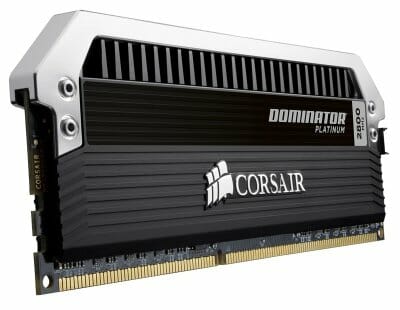
The modules look stylish and solid. The manufacturer’s hasn’t tried to save on the heatsinks which are made of thick and robust black-anodized ruffled aluminum bars. Their fins are not tall, but there is a third heatsink at the top of each module which is undoubtedly capable of dissipating the heat effectively. The last touch to the whole arrangement, making it even more robust and complete, is the shiny bracket with the engraved Dominator logo.
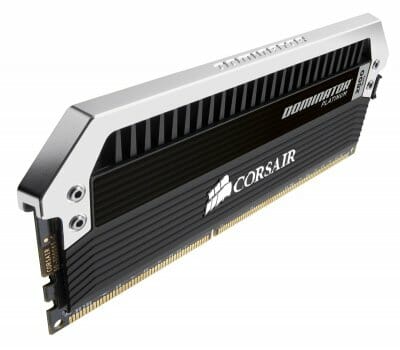
Tall heatsinks are prone to cause certain problems, though. Each Dominator Platinum module is 55 mm tall and also 7.5 mm thick, making it incompatible with large CPU coolers. We guess such modules can only be installed together with narrow tower-design coolers like the Thermalright Archon or with liquid cooling solutions which have been growing in popularity among enthusiasts.
As opposed to many other products of this class, Corsair’s new modules are much more solid. There is no flimsy detail in them. Instead of dual-sided heat-conductive scotch, the heatsinks are tightly secured with four screws, making the module virtually monolithic.
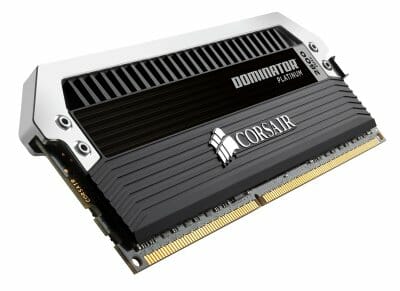
The modules have one more special feature. The shiny bracket in the top part of the module has an integrated light pipe which is highlighted with two bright white LEDs from both sides. The diffused light from them is directed downward, towards the DIMM slots, producing a beautiful white halo in a working computer. The manufacturer promises interchangeable versions of this highlighting, so modders will be able to choose from several variants.
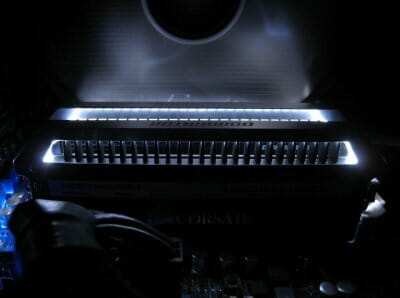
Of course, the cooling system of the Dominator Platinum combines the nice looks with high efficiency. Besides being massive and finned, the heatsinks employ Corsair’s Dual-path Heat Xchange technology. Its point is in cooling the DDR3 SDRAM chips and the PCB concurrently in two different ways. Some heat is removed in the conventional way – with heatsinks attached to the surface of the chips. And the remaining heat is removed from the chips via their pins and transferred to a metalized plate in the top part of the PCB. That plate has contact with the comb-shaped heatsink below the steel bracket. This solution ensures efficient cooling and, consequently, stable operation of the DDR3 SDRAM chips at high frequencies and heavy loads.
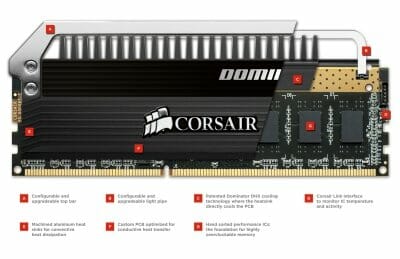
This claim can be easily checked out in practice, by the way, as the Dominator Platinum series is endowed with monitoring capabilities. Each module has a special connector to connect to a Corsair Link controller. The Corsair Link infrastructure combines hardware and software components that help you monitor and regulate parameters of your PSU, cooling and highlighting systems. Now system memory can be integrated into it as well. If you’ve got a Corsair Link controller (which is purchased separately), you can keep track of temperature and load level of each Dominator Platinum module via the Corsair Link Dashboard utility.
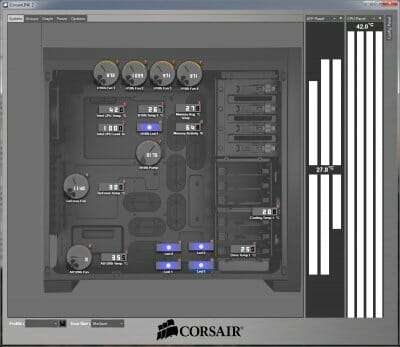
Unfortunately, monitoring Dominator Platinum modules is only supported via the Corsair Link interface. Although each module carries all the necessary circuitry and the SPD standard supports thermal sensors, the latter cannot be accessed without Corsair Link. Corsair is just trying to promote its proprietary solution to attract users to Corsair’s own components.
The Corsair Dominator Platinum series includes a lot of products with different specs: dual-channel and quad-channel kits with rated speed ranging from DDR3-1600 to DDR-2800 and a combined capacity of 8, 16 or, in some cases, 32 gigabytes. Some kits include an extra fan you can set to blow at the modules from above.
Testing Participants
We’ve got five dual-channel Dominator Platinum kits for our tests. With a combined capacity of 8 and 16 GB, they are optimized for LGA1155 platforms with Ivy Bridge CPUs:
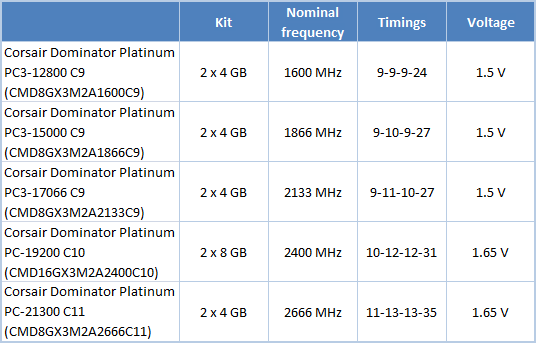
The colorful cardboard box the modules are shipped in is shaped like an octagonal prism. The cutouts in the packaging let you see stickers with product information and the top part of the heatsinks. The box itself also carries stickers with information about the included memory modules.
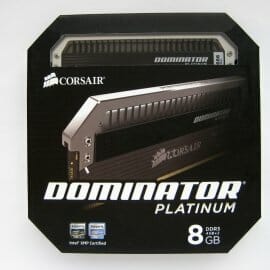
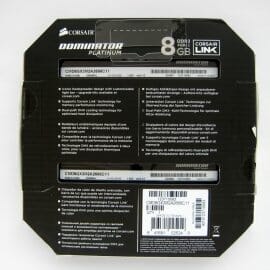
The modules are packed into individual blister wraps, fixed in a thick bar of foam rubber. There are no accessories included with the modules.
Now let’s take a closer look at each product.
Corsair Dominator Platinum PC3-12800 C9 2×4 GB (CMD8GX3M2A1600C9)
The junior product in this review isn’t really special. The clock rate of DDR3-1600 is often specified for regular DDR3 modules. However, the CMD8GX3M2A1600C9 modules sport all the special Dominator Platinum features, including the unique cooling system, highlighting and monitoring capabilities.
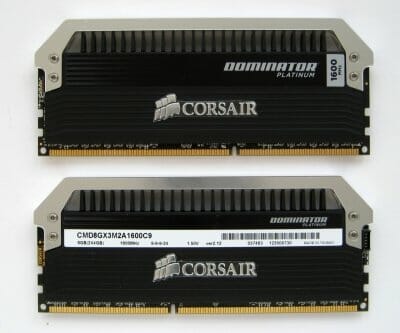
The manufacturer’s selecting best chips and testing the modules prior to their release mustn’t be forgotten, either. When it comes to reliability and warranty, the DDR3-1600 modules from the Dominator Platinum series are obviously superior to products with lower pedigree. As for components, the CMD8GX3M2A1600C9 employs Elpida chips. You don’t even have to remove the heatsinks to know that. Unlike other makers of overclocker-friendly memory, Corsair doesn’t keep the origin of its chips secret. You can learn this information from the sticker where the version number indicates the chip brand. The following table shows the correspondence between version number and chip maker:
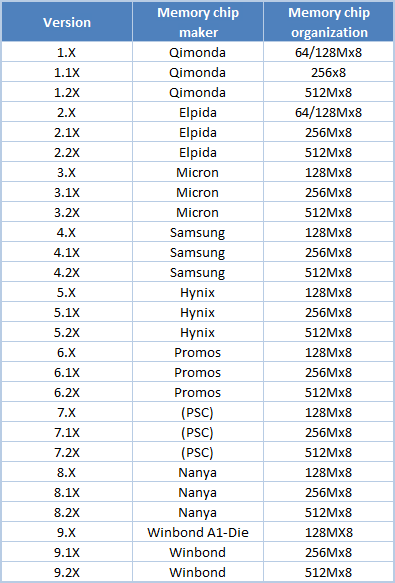
It must be noted that the stickers on Corsair memory are very informative. Besides part number, they tell you the capacity and number of memory modules in the kit, their timings, recommended voltage and the above-mentioned version number.
Even though the chips of the CMD8GX3M2A1600C9 modules are no secret, Corsair has rebranded them but the initial letters “EL” point at Elpida unequivocally.
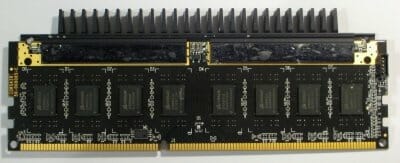
The XMP profile provides information about the specs and features of the CMD8GX3M2A1600C9 kit, like with the rest of the Dominator Platinum series products. Each of them supports XMP version 1.3.
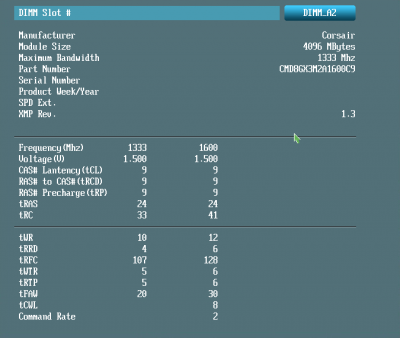
The XMP profile contains information about the single specified mode: DDR3-1600 with timings of 9-9-9-24-2T. The modules are designed for the standard DDR3 voltage of 1.5 volts, which is not surprising considering the relatively low rated frequency of the CMD8GX3M2A1600C9 kit. Besides XMP, the modules have an SPD profile. The latter containing relaxed timings and lower frequency, the kit won’t provoke any compatibility problems.
Corsair Dominator Platinum PC3-15000 C9 2×4 GB (CMD8GX3M2A1866C9)
The 1866MHz Dominator Platinum kit doesn’t seem to differ much from the above-discussed 1600MHz one. The frequency is similar, and it contains two 4GB modules, too. In both cases we have a CAS Latency of 9 and a voltage of 1.5 volts. There is no visual difference between the CMD8GX3M2A1600C9 and CMD8GX3M2A1866C9 kits, either. Once again we see a high-performance passive cooling solution and the exclusive Dominator Platinum design.
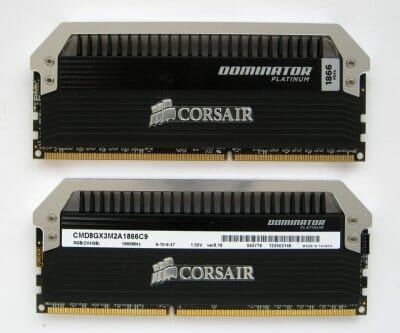
On both sides of the module we can see an embossed manufacturer logo and stickers with the series name. The most important information, i.e. the specifications of the kit, is only listed on one sticker, though. It is here that we learn that the CMD8GX3M2A1866C9 is unique in some respects. Besides its timings of 9-10-9-27, it has a version number of 8.16, which means that it employs memory chips from Nanya. Thus, the DDR3-1866 Dominator Platinum kit is based on different components than the previous product.
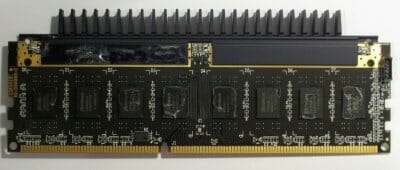
It is impossible to tell what these chips are exactly, because their original marking was erased. We can only note that Nanya chips are but rarely used in overclocker-friendly products since they do not usually have high overclocking potential.
The timings are not as aggressive as those of the DDR3-1600 kit. Besides RAS# to CAS# Delay, all of the secondary timings are relaxed. You can easily see it in the information from the single XMP profile.
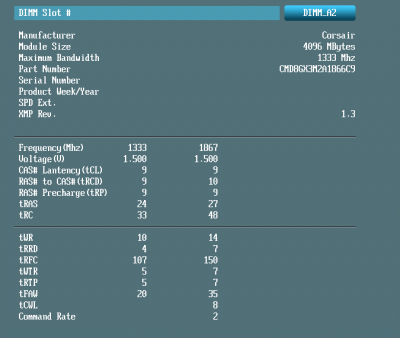
Anyway, the recommended voltage is a standard 1.5 volts, so this kit is not really a true overclocker-friendly product. It is rather meant for modders, especially as the CMD8GX3M2A1866C9 kit looks just as attractive as the rest of the Dominator Platinum series.
Corsair Dominator Platinum PC3-17066 C9 2×4 GB (CMD8GX3M2A2133C9)
True overclockers will only be interested in memory capable of working at frequencies above 2 GHz. The CMD8GX3M2A2133C9 kit is one such example but you must be aware that the price of such products grows up quickly along with their rated frequency. For example, the DDR3-2133 Dominator Platinum kit is about 40% more expensive than its DDR3-1600 and DDR3-1866 cousins of the same capacity.
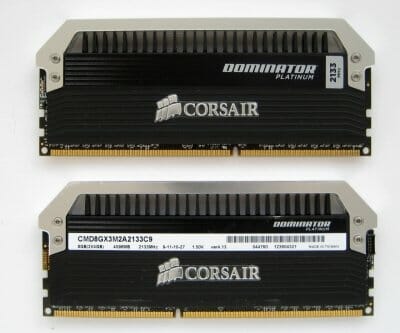
The dual-channel 8GB CMD8GX3M2A2133C9 kit stands out in the Dominator Platinum series as it has a CAS Latency of 9 and a voltage of 1.5 volts while having a rather high rated frequency. The faster products in the series have a worse CAS Latency and a higher default voltage. On the other hand, the CMD8GX3M2A2133C9 is not as good as the lower-speed products in terms of timings. This kit’s timings are 9-11-10-27.
Besides the specs, we can note the version number in the stickers. The components are different again. Version 4.13 denotes Samsung chips which are not very popular in memory modules for enthusiasts.
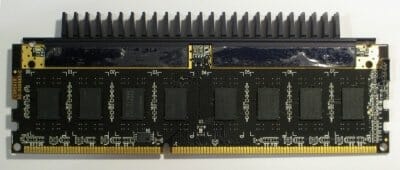
The original marking is retained on the chips of the DDR3-2133 kit. As you can see, the CMD8GX3M2A2133C9 modules use Samsung’s HCH9 chips which have come to be frequently used in overclocker-friendly products some of which are quite impressive.
The XMP profiles of the CMD8GX3M2A2133C9 modules are written according to their specs. The compatibility SPD settings are the same as with the other products discussed in this review.
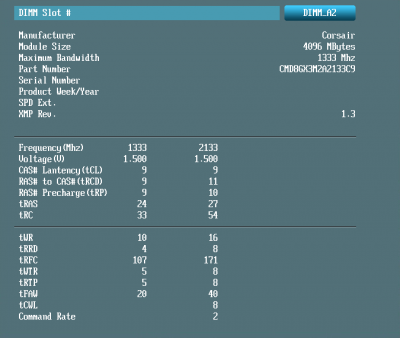
Corsair Dominator Platinum PC-19200 C10 2×8 GB (CMD16GX3M2A2400C10)
Considering the low price of system memory, many enthusiasts prefer to buy memory kits larger than 8 GB. We’ve got one such product, too. The 2x8GB CMD16GX3M2A2400C10 kit is no different from its 2x4GB cousins visually. Although there are few applications that might require as much as 16 gigabytes of memory, you can use the extra amount for a RAM disk, for example. Therefore, 16GB kits are a demanded option.
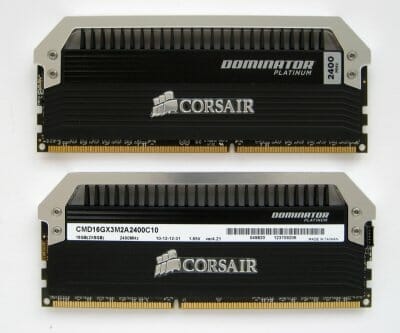
As for the specifications of the product you see in the photo, its timings are less aggressive compared to the above-discussed modules whereas its default voltage is increased to 1.65 volts. This is due to its high rated speed (DDR3-2400) rather than to capacity, though. The timings of 10-12-12-31 and increased voltage are written in the specs of the 8GB kit, too.
The version number on the sticker is 4.21. It denotes Samsung’s chips that are similar to those employed in the CMD8GX3M2A2133C9 kit but with twice the capacity.
We can check this out by dismantling the module. The Samsung HCH9 chips are from the same family as the components of the CMD8GX3M2A2133C9 kit.
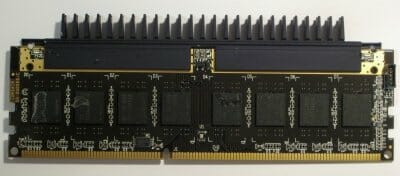
As expected, the XMP profile describes the DDR3-2400 mode and specified timings together with a voltage of 1.65 volts which is considered the peak safe voltage for modern Intel platforms.
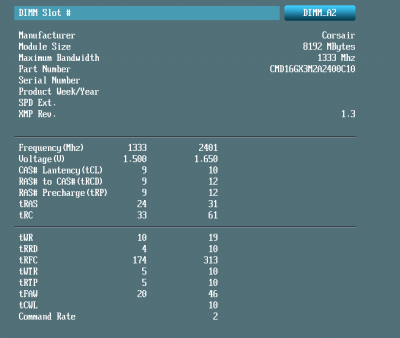
Take note that the secondary timings of the CMD16GX3M2A2400C10 kit are higher compared to the other products in this review. This is due to the large capacity, so the 16GB Dominator Platinum kits are somewhat slower than their 8GB counterparts. You’ll see this shortly in our performance tests, though.
Corsair Dominator Platinum PC-21300 C11 2×4 GB (CMD8GX3M2A2666C11)
We have never tested memory kits capable of working in DDR3-2666 mode. It is a very high speed which can only be reached through a combination of multiple factors. It doesn’t even depend entirely on the memory maker and such things as selection of best chips, good PCB wiring and efficient cooling. The mainboard and the memory controller must also be up to the mark. Anyway, Corsair has decided to release not only DDR3-2666 SDRAM, but even DDR3-2800 in the Dominator Platinum series. We’ve got a dual-channel 2x4GB kit CMD8GX3M2A2666C11 for our tests.
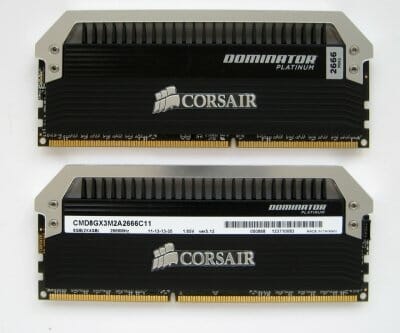
Releasing fast memory like this, the manufacturer usually provides a list of compatible mainboards but Corsair doesn’t offer any information at its official website as to what mainboards the CMD8GX3M2A2666C11 modules support at their full speed. So, if you buy such a fast memory kit, you must be confident that your CPU and mainboard can match it. The CPU must belong to the overclocker-friendly K series and the mainboard mustn’t be entry-level.
The DDR3-2666 modules look like their junior cousins. You can only identify them by the high frequency written on the label and the high timings (11-13-13-35). The voltage is of course 1.65 volts. The version number is 5.12 which means that Corsair has got a different kind of chips for each speed: the high-speed product is based on Hynix components.
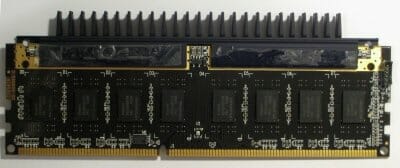
These are Hynix H5TQ2G83CFR-H9C chips that can often be found in overclocker-friendly DDR3 memory modules.
There is only one XMP profile for the CMD8GX3M2A2666C11 kit. It describes the specified DDR3-2666 mode with timings of 11-13-13-35-2T and a voltage of 1.65 volts.
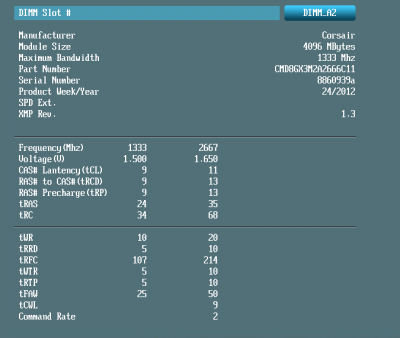
We guess a second profile with a lower frequency and more aggressive timings would be appropriate, but Corsair engineers seem to imply that DDR3-2666 is ordinary enough and doesn’t need that.
Testbed Configuration
We are going to test Corsair Dominator Platinum memory kits in an LGA 2011 system built on Asus P8Z77-V Deluxe mainboard based on the newest Intel Z77 Express chipset. Since overclocking memory modules are primarily purchased by enthusiasts, we also used Intel Core i5-3570K processor overclocked to 4.5 GHz.
As a result, the complete list of hardware and software components in our testbed looked as follows:
- CPU: Core i5-3570X, overclocked to 4.5 GHz (Ivy Bridge, 4 cores, 6 MB L3);
- CPU cooler: NZXT Havik 140;
- Mainboard: ASUS P8Z77-V Deluxe (LGA 1155, Intel Z77 Express);
- Memory:
- Corsair Dominator Platinum CMD8GX3M2A1600C9 (2 x 4 GB, DDR3-1600, 9-9-9-28);
- Corsair Dominator Platinum CMD8GX3M2A1866C9 (2 x 4 GB, DDR3-1866, 9-10-9-27);
- Corsair Dominator Platinum CMD8GX3M2A2133C9 (2 x 4 GB, DDR3-2133, 9-11-10-27);
- Corsair Dominator Platinum CMD16GX3M2A2400C10 (2 x 8 GB, DDR3-2400, 10-12-12-31);
- Corsair Dominator Platinum CMD8GX3M2A2666C11 (2 x 4 GB, DDR3-2666, 11-13-13-35).
- Graphics card: Nvidia GeForce GTX 680 (2 GB / 256 bit GDDR5, 1006/6008 MHz);
- Power supply unit: Corsair AX1200i (80 Plus Platinum, 1200 W);
- Operating system: Microsoft Windows 7 SP1 Ultimate x64;
- Drivers:
- Intel Chipset Driver 9.3.0.1025;
- Intel Management Engine Driver 8.1.2.1318;
- Intel Rapid Storage Technology 11.6.0.1030;
- NVIDIA GeForce 306.97 Driver.
Overclocking
As we showed in our special review of the memory controller in modern LGA1155 CPUs, it is the operating frequency of dual-channel memory kits that has the biggest effect on the platform’s performance. Therefore, increasing it above standard levels is the key feature of overclocker-friendly memory kits that helps ensure an additional performance boost.
Corsair’s Dominator Platinum series looks promising in this respect as they feature high-quality chips and efficient cooling. In fact, Corsair is known to endow its products with a large safety margin, so we can expect the Dominator Platinum series to be able to work at higher frequencies than their rated ones.
Here’s our algorithm of testing the overclocking potential of DDR3 SDRAM:
- Memory voltage is increased to 1.65 volts which, according to Intel, is the maximum value that doesn’t lead to degradation in the memory controller’s performance. We also increase the VCCSA voltage to 1.0 volts, which should theoretically have a positive effect on the memory controller’s stability;
- Failsafe timings of 11-13-13-31-2N are selected to find out the highest frequency the memory kit is stable at;
- Using the maximum frequency we’ve found, we then look for the most aggressive timings at which the memory kit is still stable.
The stability of the memory subsystem is verified by 10 runs of LinX 0.6.4 AVX Edition using the whole memory amount and by an additional 1-hour-long check with Memtest86+ v4.20.
Corsair Dominator Platinum PC3-12800 C9 2×4 GB (CMD8GX3M2A1600C9)
Rated for DDR3-1600, the simplest Dominator Platinum product in this review turns out to have no overclocking potential. It cannot be stable even at 1800 MHz. The best we could do with our CMD8GX3M2A1600C9 was improve its timings from 9-9-9-24-2T to 9-8-7-24-1T. The clock rate could not be increased.
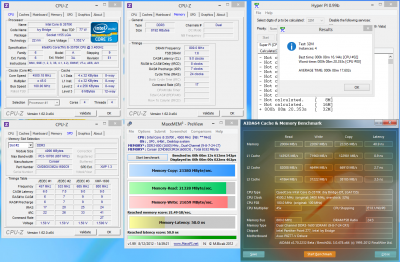
Thus, the DDR3-1600 Dominator Platinum kit is not really meant for overclockers. It can only be interesting for its modding and monitoring capabilities. If you want higher performance, you should look for more expensive and faster memory kits.
Corsair Dominator Platinum PC3-15000 C9 2×4 GB (CMD8GX3M2A1866C9)
The DDR3-1866 Dominator Platinum kit is not as dull as its DDR3-1600 cousin. It could be overclocked to DDR3-2000 but, unfortunately, not to DDR3-2133 mode.
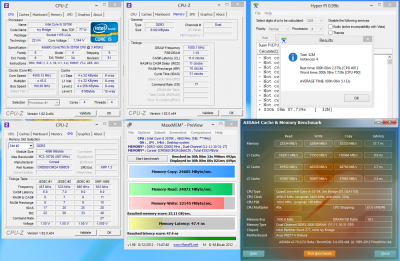
Moreover, overclocking the CMD8GX3M2A1866C9 kit to 2000 MHz called for a considerable reduction in timings. In its default mode this memory has aggressive timings with a CAS Latency of 9, but in DDR3-2000 mode it is only stable with timings of 11-11-10-31-1T and voltage increased to 1.65 volts. It looks like the manufacturer carefully selects chips for its Dominator Platinum series not only to make sure they are absolutely stable in the specified operation mode. The chips seem to be sorted out in such a way that the best components are used in the most expensive products only.
Corsair Dominator Platinum PC3-17066 C9 2×4 GB (CMD8GX3M2A2133C9)
We had some special hopes about the CMD8GX3M2A2133C9 kit which consists of two 4GB DDR3-2133 modules. This high-speed memory comes with aggressive timings and a voltage of 1.5 volts. Based on highly promising Samsung chips, it seemed to require a higher voltage and relaxed timings in order to reach much higher clock rates. We were disappointed, however. This kit couldn’t work at 2400 MHz, so we had to content ourselves with DDR3-2200 mode.
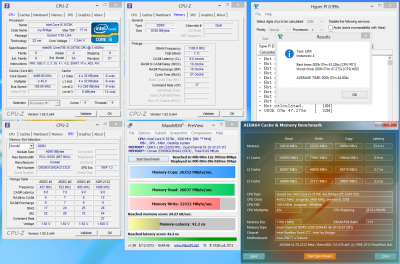
Of course, the 66MHz increase in frequency isn’t high at all, so it is not surprising that this kit was stable in DDR3-2200 mode with timings of 9-10-10-27-1T which were somewhat better than the specified ones. However, we have to admit that the junior products of the Dominator Platinum series do not overclock well. High-speed memory is more expensive and Corsair leaves no way for overclockers to save some money.
Corsair Dominator Platinum PC-19200 C10 2×8 GB (CMD16GX3M2A2400C10)
If the junior models of the Dominator Platinum series are not very good at overclocking, we can hardly expect the top-end products to be any better. They work at their best even at their default settings. The CMD16GX3M2A2400C10 illustrates this fact very well. We couldn’t overclock this DDR3-2400 kit at all.
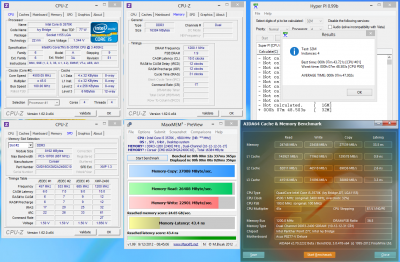
The specified settings are indeed the best settings this kit is stable at. It is not because it consists of 8GB modules. In our previous reviews we could see dual-channel 16GB kits overclock no worse than their 8GB counterparts.
Corsair Dominator Platinum PC-21300 C11 2×4 GB (CMD8GX3M2A2666C11)
The fastest memory kit of this review, CMD8GX3M2A2666C11, is similar to the CMD16GX3M2A2400C10 in having zero overclocking potential. We could not overclock this 2x4GB DDR3-2666 kit above its rated frequency.
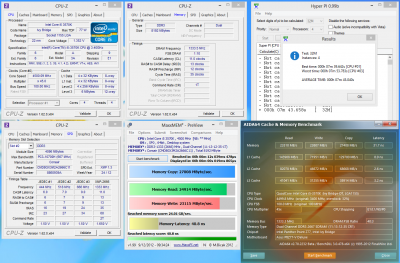
Well, we managed to lower one of the basic timings, RAS# Precharge Delay, from 13 to 12, but this can hardly have a noticeable effect on performance. The lack of any overclocking potential might be expected because DDR3-2666 and similar modules are already overclocked to their best. Every high-speed DDR3 module is going to behave like that.
The results of our overclocking experiments are summed up in the following table:
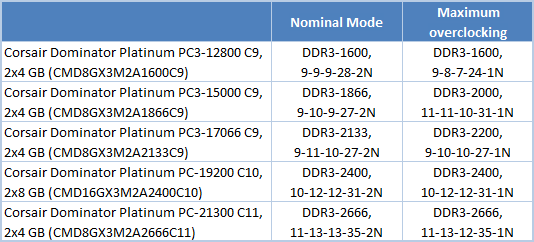
So, the Dominator Platinum series doesn’t overclock well. These memory kits are excellent in the specified mode but won’t work if you increase their frequency or improve their timings much compared to their specs.
Performance
In our performance tests we checked out the speed of our LGA1155 platform with different dual-channel memory kits from the Corsair Dominator Platinum series. Each kit was tested in two modes: 1) automatic configuring (every timing is set by the mainboard’s BIOS according to the XMP data) and 2) highest clock rates and best timings (as achieved in our overclocking tests above) set up manually in the mainboard’s BIOS.
First of all we want to run synthetic benchmarks of memory bandwidth and latency. We will use the memory test from SiSoft Sandra 2013 for that. Using a multithreaded Stream algorithm, it is perfectly suited to modern memory controllers optimized for multi-core CPUs.
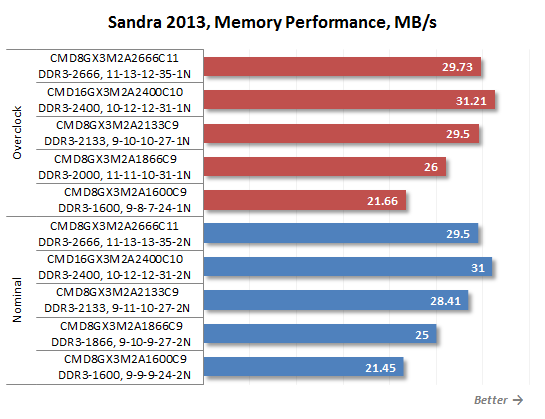
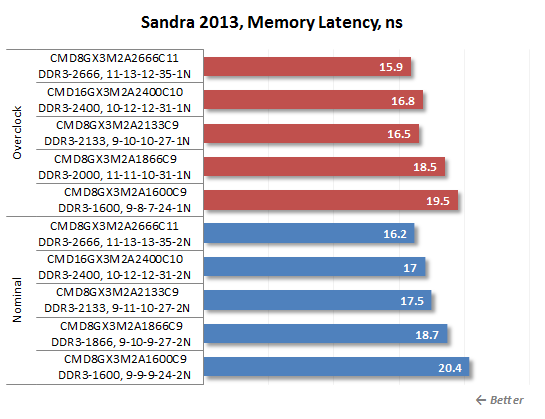
The clock rate of DDR3 SDRAM does affect memory subsystem parameters on Ivy Bridge platforms. For example, increasing the clock rate by 333 MHz helps improve the practical bandwidth by 10-20% and reduce the latency by 5-10%. However, the benefits are not so obvious at high frequencies due to poor timings. For example, the practical bandwidth may even lower on transitioning from DDR3-2400 to DDR3-2666. The latency remains the same, though, so faster memory will always ensure higher performance for your computer.
The SiSoft Sandra 2013 results suggest that it makes practical sense to be particular about choosing DDR3 SDRAM modules. However, this is a synthetic benchmark which is meant to measure how fast the CPU can work with system memory. Everyday applications are not so memory-sensitive, yet we want to check them out as well.
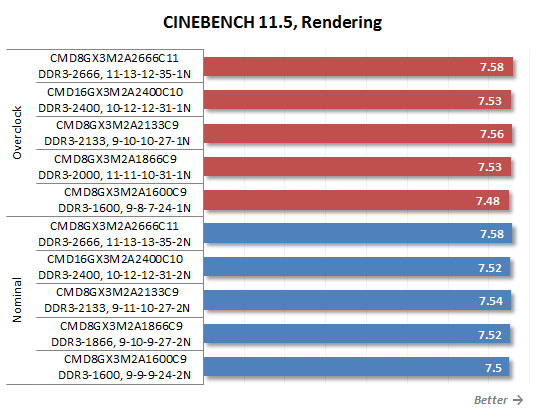
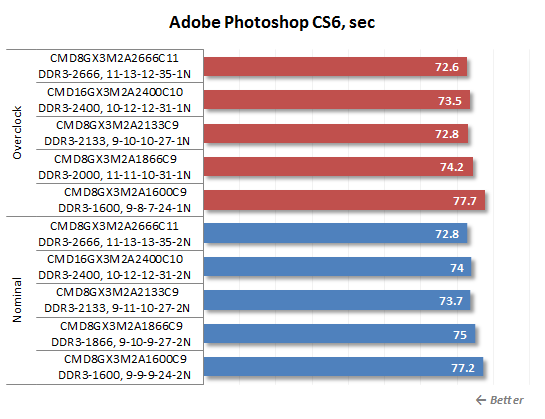
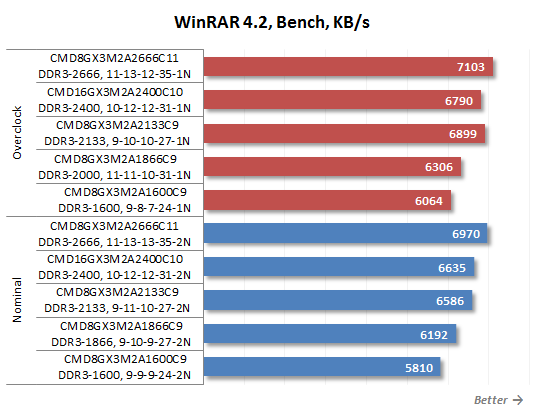
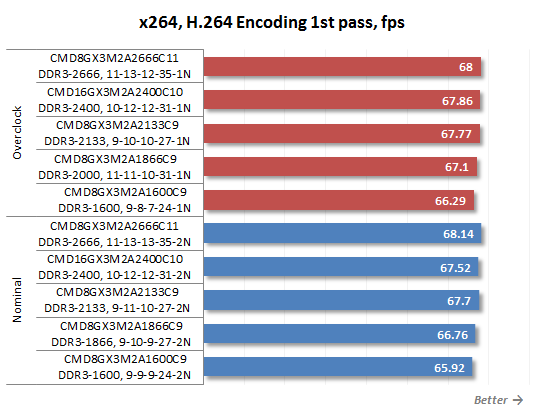
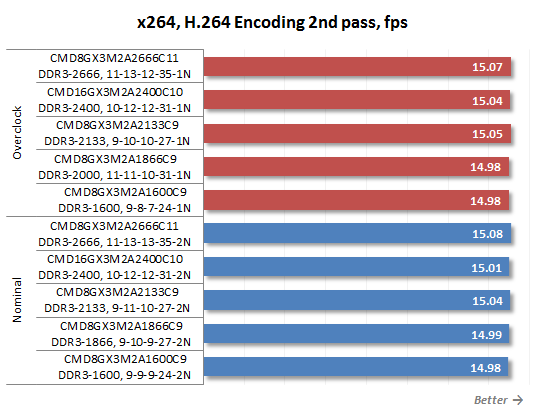
Fast memory is indeed appropriate in some situations, especially if its price doesn’t differ much from the price of ordinary products. Memory subsystem parameters can affect the speed of gaming applications, for example.
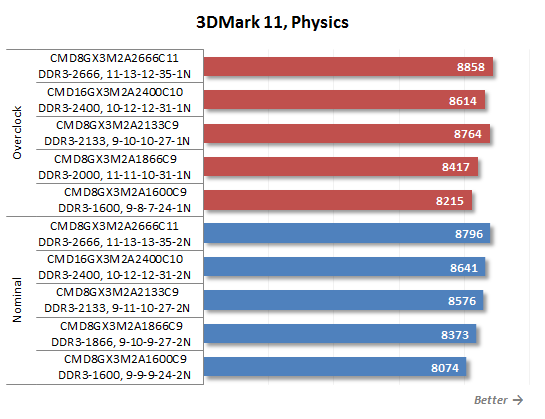
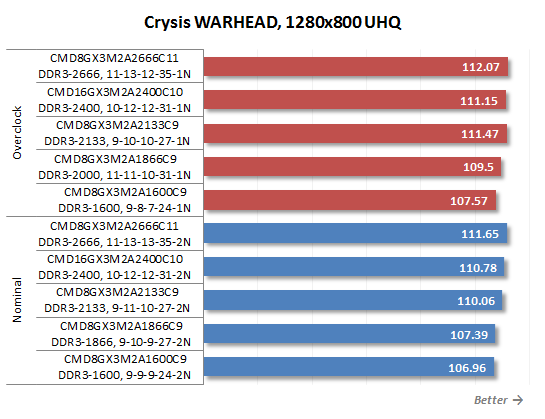
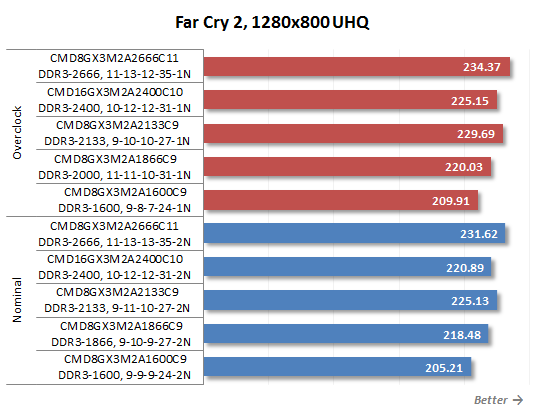
Of course, it is the graphics subsystem that influences the frame rate the most, but the memory frequency is a factor, too. Fast memory can help you improve performance by a few percent. So again, the choice of DDR3 SDRAM is quite important, especially in terms of its frequency.
There are exceptions to that rule, though. Take note of the performance of the DDR3-2400 kit CMD16GX3M2A2400C10. It is occasionally outperformed by the DDR3-2133 kit CMD8GX3M2A2133C9 because it consists of two 8GB modules which have less aggressive timings than the 4GB ones.
Conclusion
Corsair’s Dominator Platinum series is charismatic, featuring a number of positive traits no other product can offer. Besides the excellent speed, carefully selected memory chips, clever PCB wiring and unblemished reputation of the brand, these memory kits are special thanks to their exclusive exterior design. Their heatsinks are efficient in terms of cooling and effective in terms of looks. Corsair is the only maker of overclocker-friendly memory that ensures that both the chips and the PCB are cooled properly whereas the integrated highlighting will make the Dominator Platinum a jewel in a modder’s computer. You can hardly find a better solution for your system if you are into modding.
The only downside is that all of this comes at a price. The Dominator Platinum series is about twice as expensive as ordinary memory modules with similar technical specs. Therefore, it is a premium offer for a limited group of enthusiasts who can appreciate their aesthetics and enjoy their Corsair Link connectivity with extended monitoring capabilities.
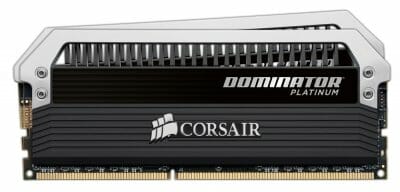
Talking about the particular products in the Dominator Platinum series, the CMD8GX3M2A2133C9 kit rated for DDR3-2133 mode seems to have the most attractive price/specs ratio. It features aggressive timings for its rather high speed and can work at a voltage of 1.5 volts. We were also impressed by the CMD8GX3M2A2666C11 kit which is the first DDR3 SDRAM we’ve seen to be able to work at 2666 MHz. Its high frequency makes the computer much faster in memory-sensitive applications: by 7 to 10% compared to ordinary DDR3-1600.
The junior Dominator Platinum products are not as attractive, in our opinion. Although they have all the external splendor of the series and are compatible with the Corsair Link, they cannot run at really high clock rates. Corsair is very precise when it comes to choosing chips for particular memory kits, so we don’t have much hope that the DDR3-1600 and DDR3-1866 kits can be overclocked to the frequencies of their senior cousins.